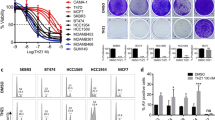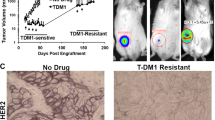Abstract
The non-receptor tyrosine kinase Fer belongs to a distinct subfamily of F-BAR domain containing kinases implicated in vesicular trafficking and signaling downstream of adhesion and growth factor receptors. Targeted inactivation of the fer gene in a transgenic mouse model of HER2+, breast cancer was associated with delayed tumor onset and reduced proliferative rates in tumor cells. Fer deficiency was associated with increased rates of epidermal growth factor (EGF)-induced epidermal growth factor receptor (EGFR) internalization and amplified Ras-Raf-Mek-Erk (Ras-MAPK) signaling in primary mammary tumor epithelial cells, as well as increased cytotoxic and anti-proliferative sensitivity to the dual EGFR/HER2 inhibitor Lapatinib (LPN). These observations suggest a model in which accelerated ligand-induced EGFR internalization in Fer-deficient cells hypersensitizes the Ras-MAPK pathway to EGF, resulting in MAPK signal amplification to levels that induce cytostasis, rather than proliferation. Thus, Ras-MAPK cytostatic signaling delays HER2 tumor initiation and increases LPN cytotoxicity in Fer-deficient model systems. Taken together, these data suggest that targeting Fer alone, or in combination with LPN, may be of therapeutic benefit in HER2+ breast cancer.
This is a preview of subscription content, access via your institution
Access options
Subscribe to this journal
Receive 50 print issues and online access
$259.00 per year
only $5.18 per issue
Buy this article
- Purchase on Springer Link
- Instant access to full article PDF
Prices may be subject to local taxes which are calculated during checkout






Similar content being viewed by others
References
Hynes NE, Lane HA . ERBB receptors and cancer: the complexity of targeted inhibitors. Nat Rev Cancer 2005; 5: 341–354.
Slamon DJ, Clark GM, Wong SG, Levin WJ, Ullrich A, McGuire WL . Human breast cancer: correlation of relapse and survival with amplification of the HER-2/neu oncogene. Science 1987; 235: 177–182.
Piccart-Gebhart MJ, Procter M, Leyland-Jones B, Goldhirsch A, Untch M, Smith I et al. Trastuzumab after adjuvant chemotherapy in HER2-positive breast cancer. N Engl J Med 2005; 353: 1659–1672.
Sebolt-Leopold JS, Herrera R . Targeting the mitogen-activated protein kinase cascade to treat cancer. Nat Rev Cancer 2004; 4: 937–947.
Sorkin A, Goh LK . Endocytosis and intracellular trafficking of ErbBs. Exp Cell Res 2009; 315: 683–696.
Sigismund S, Argenzio E, Tosoni D, Cavallaro E, Polo S, Di Fiore PP . Clathrin-mediated internalization is essential for sustained EGFR signaling but dispensable for degradation. Dev Cell 2008; 15: 209–219.
Citri A, Yarden Y . EGF-ERBB signalling: towards the systems level. Nat Rev Mol Cell Biol 2006; 7: 505–516.
Zhang Y, Opresko L, Shankaran H, Chrisler WB, Wiley HS, Resat H . HER/ErbB receptor interactions and signaling patterns in human mammary epithelial cells. BMC Cell Biol 2009; 10: 78.
Lenferink AE, Pinkas-Kramarski R, van de Poll ML, van Vugt MJ, Klapper LN, Tzahar E et al. Differential endocytic routing of homo- and hetero-dimeric ErbB tyrosine kinases confers signaling superiority to receptor heterodimers. EMBO J 1998; 17: 3385–3397.
Dankort D, Maslikowski B, Warner N, Kanno N, Kim H, Wang Z et al. Grb2 and Shc adapter proteins play distinct roles in Neu (ErbB-2)-induced mammary tumorigenesis: implications for human breast cancer. Mol Cell Biol 2001; 21: 1540–1551.
Kim L, Wong TW . The cytoplasmic tyrosine kinase FER is associated with the catenin-like substrate pp120 and is activated by growth factors. Mol Cell Biol 1995; 15: 4553–4561.
Craig AW, Zirngibl R, Williams K, Cole LA, Greer PA . Mice devoid of fer protein-tyrosine kinase activity are viable and fertile but display reduced cortactin phosphorylation. Mol Cell Biol 2001; 21: 603–613.
Jones RB, Gordus A, Krall JA, MacBeath G . A quantitative protein interaction network for the ErbB receptors using protein microarrays. Nature 2006; 439: 168–174.
Greer PA . Closing in on the biological functions of Fps/Fes and Fer. Nat Rev Mol Cell Biol 2002; 3: 278–289.
Sangrar W, Gao Y, Scott M, Truesdell P, Greer PA . Fer-mediated cortactin phosphorylation is associated with efficient fibroblast migration and is dependent on reactive oxygen species generation during integrin-mediated cell adhesion. Mol Cell Biol 2007; 27: 6140–6152.
Ivanova I, Vermeulen J, Ercan C, Houthuijzen J, Saig F, Vlug E et al. FER kinase promotes breast cancer metastasis by regulating α6- and β1-integrin-dependent cell adhesion and anoikis resistance. Oncogene 2013; 32: 5582–5592.
Aspenstrom P . A Cdc42 target protein with homology to the non-kinase domain of FER has a potential role in regulating the actin cytoskeleton. Curr Biol 1997; 7: 479–487.
Sangrar W, Craig AW, Greer PA . Fes and Fer: The F-BAR domain-containing protein-tyrosine kinases. In: Aspenstrom P (ed) The Pombe Cdc15 Homology Proteins. Landes Bioscience: Stockholm, 2009, 78–87.
Shimada A, Niwa H, Tsujita K, Suetsugu S, Nitta K, Hanawa-Suetsugu K et al. Curved EFC/F-BAR-domain dimers are joined end to end into a filament for membrane invagination in endocytosis. Cell 2007; 129: 761–772.
Frost A, Perera R, Roux A, Spasov K, Destaing O, Egelman EH et al. Structural basis of membrane invagination by F-BAR domains. Cell 2008; 132: 807–817.
Craig AW, Zirngibl R, Greer P . Disruption of coiled-coil domains in Fer protein-tyrosine kinase abolishes trimerization but not kinase activation. J Biol Chem 1999; 274: 19934–19942.
Milde-Langosch K, Bamberger AM, Rieck G, Grund D, Hemminger G, Muller V et al. Expression and prognostic relevance of activated extracellular-regulated kinases (ERK1/2) in breast cancer. Br J Cancer 2005; 92: 2206–2215.
Lee CS, Kim KL, Jang JH, Choi YS, Suh PG, Ryu SH . The roles of phospholipase D in EGFR signaling. Biochim Biophys Acta 2009; 1791: 862–868.
Amin D, Sergina N, Ahuja D, McMahon M, Blair J, Wang D et al. Resiliency and vulnerability in the HER2-HER3 tumorigenic driver. Sci Trans Med 2010; 2: 16ra7.
Vieira AV, lamaze C, Schmid SL . Control of EGF receptor signaling by clathrin-mediated endocytosis. Science 1996; 274: 2086–2089.
Phonphok Y, Rosenthal KS . Stabilization of clathrin coated vesicles by amantadine, tromantadine and other hydrophobic amines. FEBS Lett 1991; 281: 188–190.
Sousa LP, Lax I, Shen H, Ferguson SM, De Camilli P, Schlessinger J . Suppression of EGFR endocytosis by dynamin depletion reveals that EGFR signaling occurs primarily at the plasma membrane. Proc Natl Acad Sci USA 2012; 109: 4419–4424.
Disanza A, Frittoli E, Palamidessi A, Scita G . Endocytosis and spatial restriction of cell signaling. Mol Oncol 2009; 3: 280–296.
Mayor S, Pagano RE . Pathways of clathrin-independent endocytosis. Nat Rev Mol Cell Biol 2007; 8: 603–612.
Kogata N, Masuda M, Kamioka Y, Yamagishi A, Endo A, Okada M et al. Identification of fer tyrosine kinase localized on microtubules as a platelet endothelial cell adhesion molecule-1 phosphorylating kinase in vascular endothelial Cells. Mol Biol Cell 2003; 14: 3553–3564.
Laurent CE, Delfino FJ, Cheng HY, Smithgall TE . The human c-fes tyrosine kinase binds tubulin and microtubules through separate domains and promotes microtubule assembly. Mol Cell Biol 2004; 24: 9351–9358.
Martinez-Quiles N, Ho HY, Kirschner MW, Ramesh N, Geha RS . Erk/Src phosphorylation of cortactin acts as a switch on-switch off mechanism that controls its ability to activate N-WASP. Mol Cell Biol 2004; 24: 5269–5280.
Wang Z, Moran MF . Requirement for the adapter protein GRB2 in EGF receptor endocytosis. Science 1996; 272: 1935–1939.
Jiang X, Huang F, Marusyk A, Sorkin A . Grb2 regulates internalization of EGF receptors through clathrin-coated pits. Mol Biol Cell 2003; 14: 858–870.
Iwanishi M, Czech MP, Cherniack AD . The protein-tyrosine kinase fer associates with signaling complexes containing insulin receptor substrate-1 and phosphatidylinositol 3-kinase. J Biol Chem 2000; 275: 38995–39000.
Schmidt-Glenewinkel H, Vacheva I, Hoeller D, Dikic I, Eils R . An ultrasensitive sorting mechanism for EGF receptor endocytosis. BMC Syst Biol 2008; 2: 32.
Itoh T, Hasegawa J, Tsujita K, Kanaho Y, Takenawa T . The tyrosine kinase Fer is a downstream target of the PLD-PA pathway that regulates cell migration. Sci Signal 2009; 2: ra52.
Gill GN, Lazar CS . Increased phosphotyrosine content and inhibition of proliferation in EGF-treated A431 cells. Nature 1981; 293: 305–307.
Imai Y, Leung CK, Friesen HG, Shiu RP . Epidermal growth factor receptors and effect of epidermal growth factor on growth of human breast cancer cells in long-term tissue culture. Cancer Res 1982; 42: 4394–4398.
Kawamoto T, Mendelsohn J, Le A, Sato GH, Lazar CS, Gill GN . Relation of epidermal growth factor receptor concentration to growth of human epidermoid carcinoma A431 cells. J Biol Chem 1984; 259: 7761–7766.
Blagosklonny MV . Cell senescence and hypermitogenic arrest. EMBO Rep 2003; 4: 358–362.
Marshall CJ . Specificity of receptor tyrosine kinase signaling: transient versus sustained extracellular signal-regulated kinase activation. Cell 1995; 80: 179–185.
Ebisuya M, Kondoh K, Nishida E . The duration, magnitude and compartmentalization of ERK MAP kinase activity: mechanisms for providing signaling specificity. J Cell Sci 2005; 118: 2997–3002.
Wilson TR, Fridlyand J, Yan Y, Penuel E, Burton L, Chan E et al. Widespread potential for growth-factor-driven resistance to anticancer kinase inhibitors. Nature 2012; 487: 505–509.
Györffy B, Lanczky A, Eklund A, Denkert C, Budczies J, Li Q et al. An online survival analysis tool to rapidly assess the effect of 22 277 genes on breast cancer prognosis using microarray data of 1809 patients. Breast Cancer Res Treat 2010; 123: 725–731.
Das Thakur M, Salangsang F, Landman A, Sellers W, Pryer N, Levesque M et al. Modelling vemurafenib resistance in melanoma reveals a strategy to forestall drug resistance. Nature 2013; 494: 251–255.
Muller WJ, Sinn E, Pattengale PK, Wallace R, Leder P . Single-step induction of mammary adenocarcinoma in transgenic mice bearing the activated c-neu oncogene. Cell 1988; 54: 105–115.
Sangrar W, Zirngibl RA, Gao Y, Muller WJ, Jia Z, Greer PA . An identity crisis for fps/fes: oncogene or tumor suppressor. Cancer Res 2005; 65: 3518–3522.
Yu Q, Sicinska E, Geng Y, Ahnstrom M, Zagozdzon A, Kong Y et al. Requirement for CDK4 kinase function in breast cancer. Cancer Cell 2006; 9: 23–32.
Sorkin A, Duex JE . Quantitative analysis of endocytosis and turnover of epidermal growth factor (EGF) and EGF receptor. Curr Protoc Cell Biol 2010; Chapter 15, Unit15 14.
de Wit R, Hendrix CM, Boonstra J, Verkleu AJ, Post JA . Large-scale screening assay to measure epidermal growth factor internalization. J Biomol Screen 2000; 5: 133–140.
Wiley HS, Cunningham DD . The endocytotic rate constant. A cellular parameter for quantitating receptor-mediated endocytosis. J Biol Chem 1982; 257: 4222–4229.
Kumar N, Afeyan R, Kim HD, Lauffenburger DA . Multipathway model enables prediction of kinase inhibitor cross-talk effects on migration of Her2-overexpressing mammary epithelial cells. Mol Pharmacol 2008; 73: 1668–1678.
Acknowledgements
We are grateful to Lee Boudreau, Christine Hall and Yan Gao for technical assistance. This work was funded by operating grants from the Canadian Breast Cancer Foundation, the Canadian Institutes for Health Research, and the Canadian Cancer Society Research Institute to PAG.
Author information
Authors and Affiliations
Corresponding authors
Ethics declarations
Competing interests
The authors declare no conflict of interest.
Additional information
Supplementary Information accompanies this paper on the Oncogene website
Supplementary information
Rights and permissions
About this article
Cite this article
Sangrar, W., Shi, C., Mullins, G. et al. Amplified Ras-MAPK signal states correlate with accelerated EGFR internalization, cytostasis and delayed HER2 tumor onset in Fer-deficient model systems. Oncogene 34, 4109–4117 (2015). https://doi.org/10.1038/onc.2014.340
Received:
Revised:
Accepted:
Published:
Issue Date:
DOI: https://doi.org/10.1038/onc.2014.340
This article is cited by
-
FES-related tyrosine kinase activates the insulin-like growth factor-1 receptor at sites of cell adhesion
Oncogene (2018)
-
Electroporation-mediated delivery of FER gene enhances innate immune response and improves survival in a murine model of pneumonia
Gene Therapy (2018)
-
A nanomedicine approach enables co-delivery of cyclosporin A and gefitinib to potentiate the therapeutic efficacy in drug-resistant lung cancer
Signal Transduction and Targeted Therapy (2018)
-
A novel Fer/FerT targeting compound selectively evokes metabolic stress and necrotic death in malignant cells
Nature Communications (2017)
-
Electroporation-mediated delivery of the FER gene in the resolution of trauma-related fatal pneumonia
Gene Therapy (2016)



